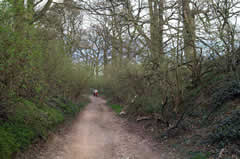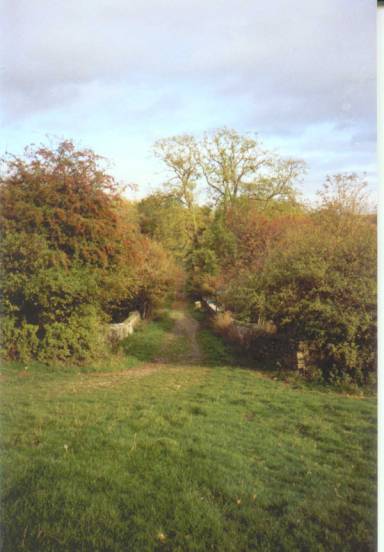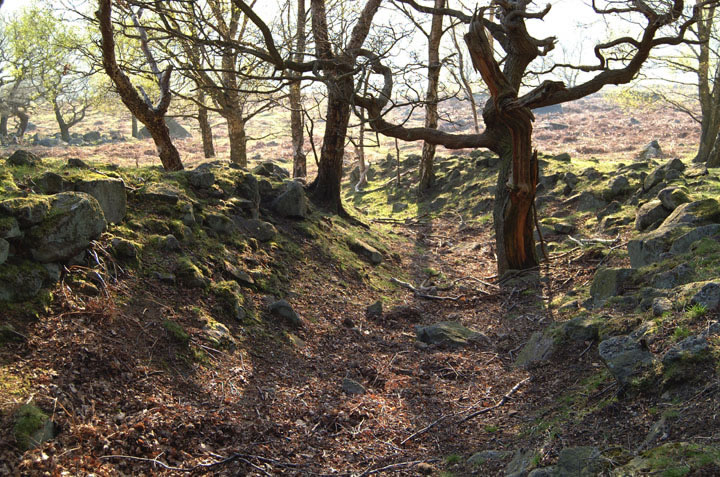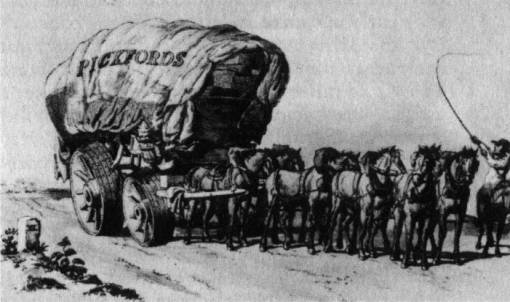
A former turnpike in England
Up to the middle of the eighteenth century, water transportation was the most effective way of moving goods and products in Scotland. Cities and towns by the ocean or by navigable rivers benefited but inland towns were effectively isolated from most trade. Only in favourable seasons could heavy goods be conveyed over the rudimentary roads. The further a town was from water, the more difficult was the transport, no matter how big the town might be. For example, as late as 1760, the entire trade between Edinburgh and Glasgow was carried on by means of ten or twelve pack horses going and returning once a week. Generally, Scottish roads were mere paths that necessity had traced out and that were marked by the prints of beasts that had traveled along them. Wheeled traffic was next to impossible most of the time. Weighty burdens of every kind were carried on horseback.
Some county gentlemen took it upon themselves to construct roads and bridges on their property. Otherwise, parish Commissioners of Supply were empowered by a 1719 statute to call upon every male between 15 and 70 years of age to give six days' work each year towards constructing and maintaining roads in the parish. Since the people of the parish saw no reason to improve the roads (what was good enough for their father was good enough for them), they avoided the statute labour to the point where a man's six days of labour frequently was equivalent to one good day of work. In many cases, the involuntary labour was commuted to a money payment.
After the Jacobite rebellion was put down in 1745, the government embarked on a program of building roads and bridges so that troops could be moved more quickly and easily than had been the case up to then. These roads were systematically engineered and constructed by the military to have a hard bottom of stones. Two King's Roads were built into the highlands through this effort.
Meanwhile, roads made by statute labour remained impassable to wheeled traffic most of the year. The abilities of the people supervising the construction varied widely and their roads were often too steep for carriages or simply followed previous roads in and out of the bogs. The general direction of the road may have been roughed out, and some bogs filled up, but the muddy nature of the land during much of the year still meant that weighted loads could be carried only in a few months of the summer. There was no real transportation network in Scotland. Responsibility ended at parish boundaries and no uniformity was possible. Surveyors were not appointed for their skills and were compelled to serve for a year against their will. They had the ability to raise local funds and were responsible for raising and supervising local statute labour, however the law was difficult to enforce due to the country-wide opposition. Any experience these surveyors gained in their year-long service was wasted by their retirement at the end of the year.
The first turnpike trust in England was established by Parliament through a Turnpike Act in 1706. (The term turnpike refers to a tollgate on which sharp pikes would be fixed as a defense against men on horseback. The intent was to prevent passage past the gate without payment.) The first turnpike act in Scotland was passed in 1750. The creation of turnpikes through England and Scotland increased dramatically in the 1750-72 period with about 15,000 miles of road being gated and tolled. Between 1760 and 1774, no less than 452 specified Turnpike Acts were passed in England/Scotland. A General Highways Act was passed in 1773 which consolidated the previous legislation.
The turnpike acts created Turnpike Trusts which assumed a parish's responsibilities for road construction and maintenance. The Trusts borrowed money for the construction of the roads and were allowed to maintain the roads using money collected via tolls. They were required to erect signpost along the route and milestones were also installed to allow for calculation of tolls. Salaried surveyors were to be appointed by justices of the peace out of lists of names submitted by each parish and the six day statute labour could be commuted by money payments.


Above, these trails used to be turnpikes. (These images are from the English countryside.)
A degree of standardization followed. Some counties required roads to be at least twenty feet in width in addition to the ditches on either side which were to be five feet wide. (Many of the roads were so narrow that not only could wheeled carriages not pass by one another, even horses loaded with curracks could not pass each other.) Roads were also directed to be raised in the middle so that water might run off them. Tenants who had farm lands adjacent to the roads were ordered to cease ploughing across the roads. However, the quality of the turnpikes varied from one location to another. In some cases, turnpikes had no drains and consisted merely of piles of rubble thrown onto the ruts.
Still, the effect on people's lives was dramatic. Villages that had previously been isolated were now connected to larger trade centers. The improved transportation facilitated the broad sweeping changes that were being made possible by the Industrial Revolution and the accompanying Agricultural Revolution. Farm production levels increased because farmers could now import fertilizer. The excess produce was exported to the larger centers, which in turn, meant that the farmers now had money that they could use to purchase new equipment and more fertilizer. Village artisans who previously had made clothes for just their own family could now take local materials (which were in larger supply because of improved farming techniques) and sell their textile products to larger centers.

While Scotland's transportation was greatly improved through the turnpikes, it would be an exaggeration to claim that an effective network came into place. As already noted, road quality varied widely. The costs of transportation for the average Scot were not diminished. Yes, they could avoid the statute labour requirement, but only by paying a compensatory fee. Moreover, farmers had to pay a fee for passing through the tollgates with carts or packhorses or if they had to drive their animals through. This increasingly became a problem as fields became enclosed. The wealthy with their carriages or the merchants with their wagons benefited by the reduced time and discomfort of their trip; however, as far as their personal transportation was concerned, the average Scot still walked or rode on horseback.
The turnpike system was not universally popular but it allowed the creation of a network of stage-coaches giving relatively fast travel between the main towns of Scotland and into England. Travel was neither comfortable nor cheap. The coaches had room for a mere six passengers inside sitting on unsprung horsehair seats, with a further twelve on top sitting on bare wooden planks. Here's a description of a traveler's experience traveling from Edinburgh to Aberdeen.
At four o'clock PM set out for the north on top of the mail. In thirty-five minutes we reached Queen's Ferry, a distance of nine miles, and were in Perth (including half an hour or more at Queen's Ferry) in four and a half hours, forty two miles.
The Edinburgh coachman seemed to have inspired his brother of the Highland road, for there was no lack of driving through the Vale of Athole. Down we swept one hill, and the impetus brought us half way up another. The quick turns were taken, sometimes within six inches of the stones placed to define the edge of the road, or the corner of a bridge; still, neither these, nor the belting or the kicking of some of the horses, nor the darkness of the night, diminished our steady pace of ten or twelve miles an hour. It was very dark until about two in the morning, and being an old traveller, I dozed, well protected by greatcoats between two less prudent passengers. I like to ride outside, if well protected, on a summer night, the pure morning air being so fresh.
A great impetus was given to stagecoaches by an association of some country gentlemen, chiefly Mr. Ramsay of Barnton, Mr. Barclay of Ury, Lord Glen Lyon, afterwards Duke of Athole and others. They started a coach between Edinburgh and Aberdeen. Their coaches were luxurious and handsome, the horses beautifully matched and of the first character, harness in good taste and of the best quality. The drivers and guards in their uniform of red coats and yellow collars were steady and respectable men, great favourites on the road, obliging, full of conversation and local knowledge, and several of these played with no small talent on the bugle and cornet. Time was kept to a minute, and so complete and perfect was the whole establishment that a highly paid veterinary surgeon was employed to tend the horses and see they were properly looked to.
While fine in theory, the concept of Turnpike Trusts did not actually work. They satisfied the immediate, urgent need. But the heavy interest on the loans raised by the trustees, the excessive cost of management, and the profits exacted by those who collected the tolls all reduced the margins that were left for road expenditure. To increase the funds, tolls were increased but they still couldn't support a system which had to rely on statute labour and had to find funds to purchase land and road material.
Thus, in reality, the Turnpike Trust debt was never paid off. Trusts were simply renewed as needed. The quality of road construction improved slowly, but roads still became waterlogged. By the 19th century, advances in surveying and road construction led to more appropriate routes and better road surfaces (e.g., macadam roads). But, the introduction of rail travel provided faster and cheaper transport. Without freight income, the turnpike era died a slow death and, in time, the responsibility for roads once again reverted to local authorities.
Sources
Various web sites, including
Perthshire Diary (http://www.perthshirediary.com)
Rural Life in the 18th Century (www.electricscotland.com/history/rural_lifendx.htm)
Soil and Health Library (http://www.soilandhealth.org/01aglibrary/010136ernle/010136ch13.htm)
Toll Roads and Landscape (http://freepages.genealogy.rootsweb.com/~acwager/html/TollRoadsAndEnglishLandscape.htm)